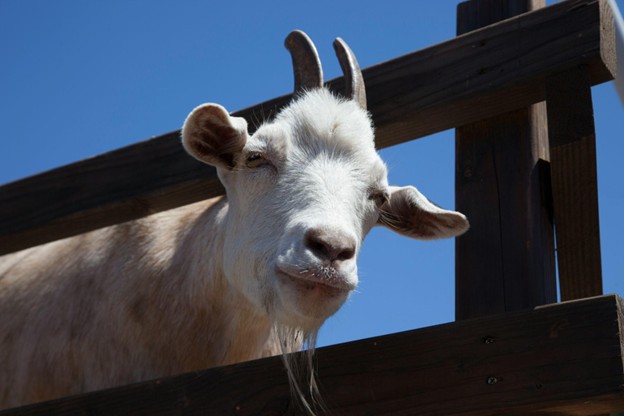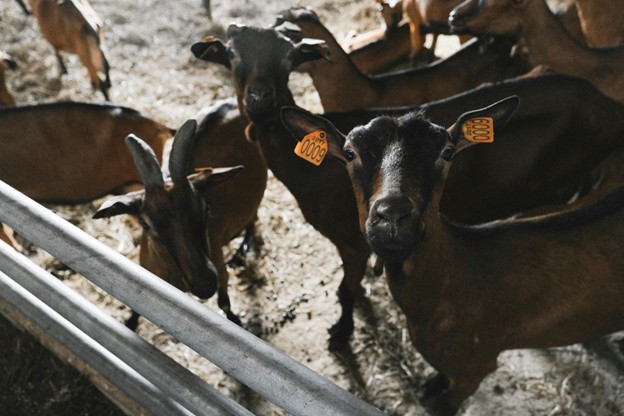Pregnancy Toxemia/Ketosis in Goats: Causes, Symptoms, and Treatment

Pregnancy Toxemia in goats is a metabolic disorder that arises when the animal's energy demands exceed its nutritional intake. It is most common during late pregnancy or early lactation, when energy requirements are high. The condition leads to the breakdown of fat for energy, producing excess ketone bodies in the blood.
If left untreated, Pregnancy Toxemia can cause weakness, loss of appetite, reduced milk output, and, in severe cases, death. Early detection and proper management are critical to prevent these complications. Controlling Pregnancy Toxemia is essential for maintaining herd health, farm productivity, and overall economic sustainability.
What is Pregnancy Toxemia in Goats?

Pregnancy Toxemia in goats is a metabolic disorder that occurs when their energy needs exceed their nutritional intake, especially during late pregnancy or early lactation. In this state, the goat's body breaks down fat for energy, producing excess ketone bodies in the blood, which can be harmful if not managed.
Several factors increase the risk of Pregnancy Toxemia. Goats carrying multiple kids, high-producing breeds with greater energy demands, older does, underweight animals, or those fed low-quality or insufficient feed are more susceptible. Stress, sudden dietary changes, and concurrent illnesses can also trigger the condition.
Calculate your animal's gestation stage with our Goat Gestation Calculator to plan feeding and care.
Causes of Pregnancy Toxemia in Goats

Pregnancy Toxemia develops when a goat's energy needs exceed the energy she receives from her feed, forcing her body to use stored fat as a source of fuel. This fat breakdown produces ketone bodies, which, in excess, lead to Pregnancy Toxemia.
Common causes include:
- Late Pregnancy (Especially Multiple Pregnancies): Does carrying twins or triplets have higher energy demands, which often exceed what they can consume through feed.
- Early Lactation: High milk-producing does require additional energy, and insufficient intake can trigger Pregnancy Toxemia.
- Poor-Quality or Insufficient Feed: Diets low in energy, high in fiber but low in digestible nutrients, or limited feed availability can lead to an energy deficit.
- Older or Underweight Animals: Goats with lower body reserves are less able to cope with high energy demands.
- Sudden Dietary Changes: Abrupt changes in feed type or quality can stress metabolism and precipitate Pregnancy Toxemia.
- Stress Factors: Environmental stressors such as extreme weather, overcrowding, or transport can increase susceptibility.
- Concurrent Illnesses: Diseases that reduce appetite or increase energy requirements, such as parasitic infections, can trigger Pregnancy Toxemia.
Symptoms of Pregnancy Toxemia in Goats
Pregnancy Toxemia can develop gradually, and its signs are often easy to miss in the early stages. The common symptoms include:
- Loss of Appetite or Reduced Feed Intake: Affected goats often refuse feed or eat very little, worsening energy deficiency.
- Rapid Weight Loss: Noticeable reduction in body condition occurs as fat stores are mobilized for energy.
- Weakness and Lethargy: Goats may appear tired, reluctant to move, or have difficulty standing.
- Decreased Milk Production: Lactating does show a drop in milk yield due to an energy shortage.
- Nervous Signs: Some goats may show aimless walking, tremors, or unusual behavior due to the effects of ketones on the nervous system.
- Sweet or Fruity Breath and Urine: A characteristic odor develops from high levels of ketone bodies.
- Severe Cases: If untreated, goats may collapse, become comatose, or die.
Not sure if your goat is pregnant? Check out our guide to Goat Pregnancy Signs.
Detecting Early Pregnancy Toxemia in Goats
Early detection is key to minimizing losses and preventing the condition from progressing. Farmers can watch for:
- Reduced appetite or selective feeding
- A sudden drop in milk output or slower weight gain
- Dullness, reduced activity, or mild lethargy
- A rapid loss of body weight and a prominent spine and rump
- Opt for routine urine or blood tests to check the ketone levels in the blood
Diagnosing Pregnancy Toxemia in Goats

Symptoms like weight loss, weakness, or reduced milk production can also result from parasites, infections, or other metabolic disorders, which is why differential diagnosis is important. You can opt for:
- Clinical Examination: Veterinarians assess appetite, body condition, hydration, and behavior.
- Urine Tests: Ketone test strips can detect acetoacetate or acetone in urine.
- Blood Tests: Measurement of beta-hydroxybutyrate (BHBA) levels in the blood provides a precise diagnosis.
Treatment for Pregnancy Toxemia in Goats

Here are the standard treatments for Pregnancy Toxemia in goats:
- Immediate Energy Supplementation: Oral glucose solutions, propylene glycol, or commercial energy gels can help restore energy balance.
- Oral Sugars: Corn, molasses, sweet feed, and/or corn syrup can also be administered to increase caloric intake.
- Corrective Feeding: Provide high-energy, easily digestible feed, including grains or concentrates, along with adequate forage.
- Fluids and Electrolytes: In severe cases, intravenous fluids may be required to correct dehydration and metabolic imbalances.
- Veterinary Care: Administer B-vitamin injections, particularly thiamine, as recommended by a veterinarian.
- Monitor Recovery: Continue feeding high-energy diets and monitor ketone levels until the goat returns to normal appetite, weight, and activity.
- Address Underlying Causes: Reduce stress, adjust nutrition, and manage concurrent illnesses to prevent recurrence.
Note: If there is no response to treatment within 24 hours, a veterinarian should be contacted for more aggressive treatment.
Prevention of Pregnancy Toxemia in Goats
Preventing Pregnancy Toxemia starts with proper nutrition and management, especially during late pregnancy and early lactation.
- Balanced Nutrition: Ensure does receive a balanced diet rich in energy, protein, and essential minerals.
- Nourishing Feed: Offer high-quality forages and supplement with grains or concentrates as energy demand increases.
- Smooth Dietary Transitions: Avoid sudden feed changes, and ensure goats always have access to clean water.
- Regularly Monitor Body Condition: Overconditioned or underweight does are more prone to Pregnancy Toxemia.
- Minimize Stress: Reduce stress during gestation by providing comfortable housing and avoiding overcrowding.
- Sugar Supplements: Add a small amount of fat, like corn oil, or add molasses or corn syrup to provide easily digestible energy.
- Vet Visits: Routine health checks and parasite control also play a key role in prevention.
Impact of Pregnancy Toxemia in Goats on Offspring and Herd Productivity
Pregnancy Toxemia doesn't just affect the doe; it can also have serious consequences for her kids and overall herd performance. In pregnant goats, Pregnancy Toxemia can lead to poor fetal development, stillbirths, or weak kids at birth. Surviving kids may have slower growth rates and lower survival chances.
For the herd, Pregnancy Toxemia causes reduced milk output, delayed breeding cycles, and increased veterinary costs, all of which impact farm profitability. Frequent cases can disrupt kidding schedules and strain herd management. Maintaining metabolic health is therefore essential to sustain reproductive efficiency, kid survival, and long-term productivity in the flock.
Read our Goat Breeding Methods for herd planning tips to lower metabolic disorder risk.
How Pregnancy Toxemia in Goats Differs in First Pregnancy vs. Multiple Pregnancies

Similarities
- Both require increased nutrition and careful monitoring during late pregnancy.
- Proper feed quality, stress control, and routine health checks are essential.
- Energy imbalances in either case can lead to Pregnancy Toxemia if not managed promptly.
Differences
- Does with multiple pregnancies face higher energy demands and a greater risk of Pregnancy Toxemia.
- Feed intake is often more restricted in multiple-bearing does due to limited abdominal space.
- Post-kidding Pregnancy Toxemia is more common and severe in high-producing, multi-bearing goats.
Use FarmKeep for Goats Pregnancy Management
Efficient herd management relies on accurate tracking of breeding, pregnancy, and kidding. FarmKeep is advanced breeding software that helps goat farmers boost productivity, reduce reproductive losses, and make informed management decisions.
Heat Detection Alerts: Monitors activity and estrus cycles, sending alerts when does are in heat for timely breeding.
Breeding Records: Built-in calendars for various goat breeds help track cycles, pregnancies, and performance easily.
Automatic Alerts: Calculates gestation periods and notifies you of pregnancy checks, expected kidding dates, and labor times.
Better Decisions: Centralized reproductive data supports smarter nutrition, health, and breeding strategies.
Improved Productivity: Optimized breeding and kidding schedules enhance herd efficiency and kid spacing.
Kidding Alerts & Records: Get notified before kidding, track kid details, and record birth data for future planning.
Animal History & Pedigree: Access complete breeding histories to strengthen genetic selection.
Health Logs: Record vaccinations and treatments to maintain complete herd health records.
Pasture Management: Track grazing rotations for balanced nutrition during pregnancy.
Cloud Sync: Access real-time reports; ideal for large or multi-location goat herds.
FAQs
What is Pregnancy Toxemia in goats?
Pregnancy Toxemia is a metabolic disorder in pregnant goats that happens when their energy needs are higher than what they get from feed. The body starts breaking down fat for energy, producing excess ketones that build up in the blood. This leads to weakness, loss of appetite, and reduced milk production if not managed in time.
What causes Pregnancy Toxemia in pregnant goats?
Pregnancy Toxemia in pregnant goats, also called pregnancy toxemia, is mainly caused by high energy demands during late gestation, especially in does carrying multiple kids, combined with poor-quality or insufficient feed, sudden dietary changes, stress, or illness.
What are the common symptoms of pregnancy toxemia in goats?
Typical signs of pregnancy toxemia in goats include loss of appetite, weakness, dullness, rapid weight loss, reduced movement, and a sweet or fruity odor on the breath. In advanced cases, affected does may become recumbent, show nervous signs, or die if untreated.
How can you prevent pregnancy toxemia in goats?
Prevention involves balanced, energy-rich feeding during late pregnancy, avoiding abrupt feed changes, reducing stress, maintaining body condition, and providing high-quality forage with grain supplements. Regular monitoring of high-risk does is essential.
What are the early signs of Pregnancy Toxemia in goats?
Early indicators include decreased appetite, lethargy, and reduced feed intake. Affected goats may isolate themselves, lose body condition, and show a slight decline in milk production. These signs require immediate dietary adjustment or veterinary care.



